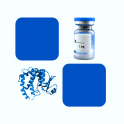
- Remove this product from my favorite's list.
- Add this product to my list of favorites.
Products
Viewed products
Newsletter
 |  |  |  |  |  |

Background
The progression of pancreatic cancer (PC) is significantly associated with tumor immune escape, which may be associated with nature killer (NK) cell dysfunction. CD226, CD96, and TIGIT, which share the ligand CD155, play important roles in the regulation of NK cell function. The present study was conducted to investigate the roles of these molecules in NK cells from PC patients. TIGIT and CD96 together with the co-stimulatory receptor CD226 form a pathway that is analogous to the CD28/CTLA-4 pathway, in which shared ligands and differential receptor:ligand affinities fine-tune the immune response. Although the roles of TIGIT and CD96 as immune checkpoint receptors in T cell and natural killer cell biology are just beginning to be uncovered, accumulating data support the targeting of these receptors for improving anti-tumor immune responses. A clear understanding of the immune cell populations regulated by TIGIT and CD96 is key to the design of immunotherapies that target these receptors in combination with other existing immune checkpoint blockade therapies. The dysfunction of CD96 may trigger C syndrome: A syndrome characterized by trigonocephaly, severe mental retardation, hypotonia, variable cardiac defects, redundant skin, and dysmorphic facial features, including upslanted palpebral fissures, epicanthal folds, depressed nasal bridge, and low-set, posteriorly rotated ears.
Source
Recombinant Biotinylated Human CD96, His,Avitag (TAE-H82E3) is expressed from human 293 cells (HEK293). It contains AA Val 22 - Met 503 (Accession # P40200-2).
Predicted N-terminus: Val 22
Molecular Characterization
This protein carries a polyhistidine tag at the C-terminus, followed by an Avi tag (Avitag™).
The protein has a calculated MW of 57.3 kDa. The protein migrates as 120-130 kDa under reducing (R) condition (SDS-PAGE) due to glycosylation.
Biotinylation
Biotinylation of this product is performed using Avitag™ technology. Briefly, the single lysine residue in the Avitag is enzymatically labeled with biotin.
Biotin:Protein Ratio
Passed as determined by the HABA assay / binding ELISA.
Endotoxin
Less than 1.0 EU per μg by the LAL method.
Purity
>80% as determined by SDS-PAGE.
Formulation
Lyophilized from 0.22 μm filtered solution in PBS, pH7.4. Normally trehalose is added as protectant before lyophilization.
Reconstitution
Please see Certificate of Analysis for specific instructions.
For best performance, we strongly recommend you to follow the reconstitution protocol provided in the CoA.
Storage
For long term storage, the product should be stored at lyophilized state at -20°C or lower.
Please avoid repeated freeze-thaw cycles.
This product is stable after storage at:
-20°C to -70°C for 12 months in lyophilized state;
-70°C for 3 months under sterile conditions after reconstitution.
Bioactivity
Please refer to product data sheet.
(1) "Twenty-four-color full spectrum flow cytometry panel for minimal residual disease detection in acute myeloid leukemia"
Chen, Fu, Gong et al
Open Med (Wars) (2023) 18 (1), 20230745
(2) "Identification of cell death-related biomarkers and immune infiltration in ischemic stroke between male and female patients"
Chen, Chen, Wu et al
Front Immunol (2023) 14, 1164742
(3) "AKT inhibition interferes with the expression of immune checkpoint proteins and increases NK-induced killing of HL60-AML cells"
Gama, Varela, Ribeiro et al
Einstein (Sao Paulo) (2023) 21, eAO0171
Showing 1-3 of 229 papers.
Follow us